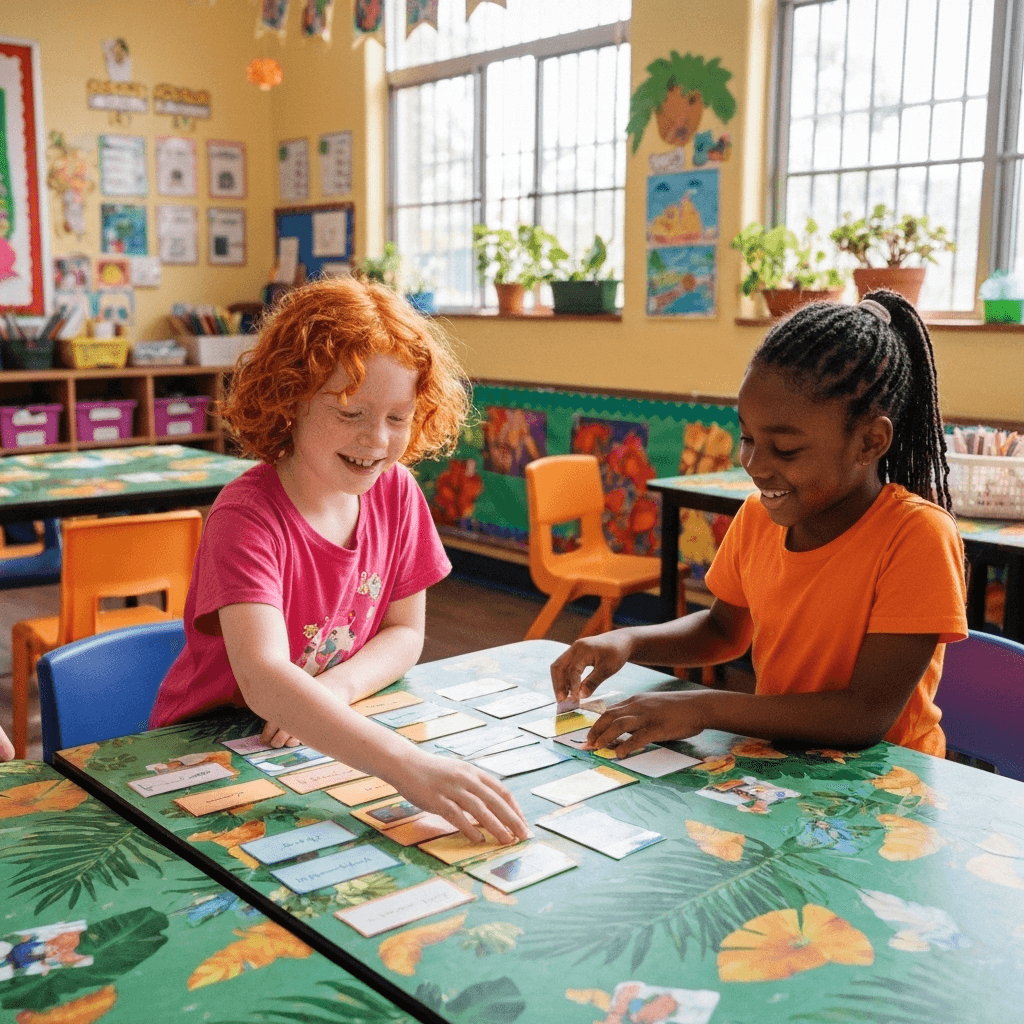Story Sequence Cards
A hands-on reading comprehension activity that helps students understand story structure and develop retelling skills through visual sequencing.
Activity Overview
Story Sequence Cards is an engaging reading comprehension activity where students listen to or read a story, then arrange picture cards in the correct chronological order. This hands-on approach helps young learners understand story structure, develop sequencing skills, and practice retelling stories with proper beginning, middle, and end organization. The visual nature of this activity supports diverse learning styles and makes abstract story concepts concrete and manageable.

Learning Outcomes
- Develop understanding of story structure (beginning, middle, end)
- Practice sequencing events in chronological order
- Improve listening comprehension and attention to detail
- Enhance retelling skills using visual prompts
- Build vocabulary through story discussion
- Strengthen memory and recall abilities
- Develop confidence in oral storytelling
Curriculum Connections
ELO 2: Learners will comprehend and respond personally and critically to oral, print, and other media texts.
- SCO 2.1: Experience various texts
- SCO 2.2: Attend to and comprehend oral, print, and other media texts
- SCO 2.3: Demonstrate comprehension of texts
ELO 3: Learners will manage ideas and information.
- SCO 3.1: Plan and focus
- SCO 3.2: Select and process
- SCO 3.3: Organize, record, and evaluate
Implementation Steps
1Preparation (5-10 minutes)
- Select an age-appropriate story with clear sequence of events
- Prepare 4-6 picture cards representing key story events
- Set up workspace with pocket chart or table space for arranging cards
- Have sentence strips ready for advanced students
- Prepare discussion questions about story elements
2Story Introduction (5-10 minutes)
- Introduce the story title and make predictions
- Discuss key vocabulary that will appear in the story
- Set a purpose for listening: "Listen for the order of events"
- Show the sequence cards briefly without revealing the order
- Explain that students will arrange these cards after the story
3Story Reading/Listening (10-15 minutes)
- Read the story aloud with expression and appropriate pacing
- Use visual cues and gestures to support comprehension
- Pause occasionally to check understanding
- Encourage active listening through body language and engagement
- Read the story a second time if needed for comprehension
4Sequencing Activity (15-20 minutes)
- Display the sequence cards in random order
- Have students work in pairs or small groups to discuss the order
- Guide students to identify the beginning event first
- Continue with middle events, discussing clues that show order
- Conclude with the ending event
- Use transition words: "First," "Next," "Then," "Finally"
5Retelling and Discussion (10-15 minutes)
- Have students retell the story using the arranged cards as prompts
- Encourage use of sequence words and descriptive language
- Ask comprehension questions about characters, setting, and problem
- Discuss how the sequence cards helped with understanding
- Allow students to act out parts of the story if time permits
Activity Variations
Individual Sequencing
Give each student their own set of mini sequence cards to arrange independently before sharing with the group.
Digital Sequencing
Use interactive whiteboard or tablets to drag and drop digital story cards into correct sequence.
Story Creation
Provide blank cards for students to draw their own story sequence, then share with classmates to arrange.
Text Addition
Add sentence strips under each picture card to combine visual and text sequencing skills.
Differentiation Strategies
For Students Who Excel
- Provide more complex stories with additional sequence cards
- Challenge them to create their own sequence cards for classmates
- Add writing component: write sentences to match each card
- Introduce cause-and-effect relationships between events
For Students Who Need Support
- Start with 3-4 cards instead of 5-6
- Use very clear, distinct pictures with obvious sequence
- Provide verbal prompts and guided questioning
- Allow peer partnerships for support
- Use familiar stories students already know
Language Considerations
- Use stories that reflect students' cultural backgrounds
- Allow retelling in Home Language first, then English
- Provide visual vocabulary cards for key story words
- Encourage use of gestures and expressions during retelling
Assessment Rubric
Sequencing Accuracy
- Excellent: Correctly sequences all events
- Good: Sequences most events with 1 error
- Developing: Sequences some events correctly
- Beginning: Needs significant support
Retelling Quality
- Excellent: Complete retelling with details
- Good: Includes main events and some details
- Developing: Basic retelling with prompts
- Beginning: Minimal retelling, needs support
Use of Sequence Words
- Excellent: Uses varied transition words
- Good: Uses basic sequence words consistently
- Developing: Uses some sequence words
- Beginning: Rarely uses sequence words
Materials and Preparation Tips
Essential Materials
- Picture books with clear sequence of events
- Laminated picture cards (4-6 per story)
- Pocket chart or table space for arranging
- Optional: sentence strips for advanced learners
Preparation Tips
- Choose stories with 4-6 distinct, visual events
- Make cards large enough for whole group viewing
- Include key story elements in your picture selection
- Test the sequence with colleagues before using
